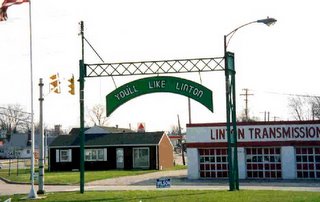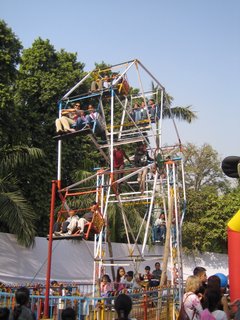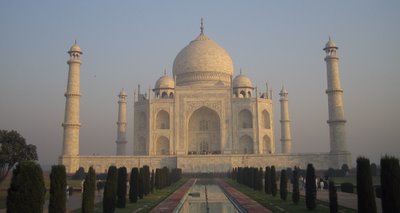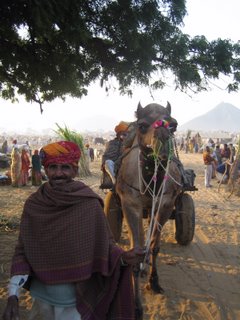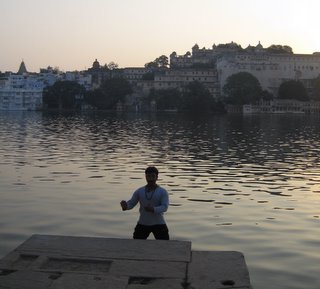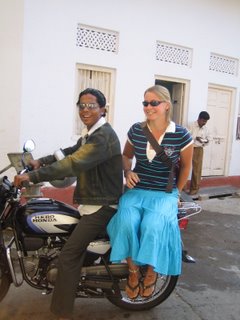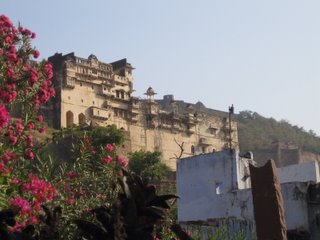At the same fair where we saw the human-driven ferris wheel, they had raffle tickets for plane flights sponsored by various airlines. They were 50 or 100 rupees a raffle, so on a whim, Dave and I entered a few of them. Not bothering to stay around until 4:30 when the drawing was, Dave and I wrote our cell numbers on the raffle tickets and left the fair. I honestly forgot about the raffle--I figured it was for charity, and that was enough.
Well, you can imagine my surprise when a few hours later I got a call from a very pleasant Indian matron who informed me that I'd won a voucher for two free plane tickets from Delhi to Goa! (Actually, they were for either "Delhi Mumbai Delhi, Delhi Goa Delhi, or Delhi Pune Delhi; yourrr choice." She said it exactly this way at least three times, with a roll of the R.) She said further that I could come to her apartment in Gurgaon, the trendy "growth" suburb of Delhi, to get the prize voucher. Finally, she mentioned that I'd need to bring the winning raffle ticket.
And that's where the problems began. Looking through my pockets, I realized I didn't have the winning raffle ticket anymore! I had every other raffle ticket, Dave had all his raffle tickets, I was missing that one raffle ticket that was needed! I looked through the bag I brought with me to the fair. Traced my footsteps since arriving back at the apartment, I double checked everything. No ticket. I called the person who was kind enough to give us a ride back from the fair, asking him to check his car; nope. I began contemplating how funny it would be if I never found the ticket; easy come, easy go. I started to concoct plans to convince the pleasant Indian matron that I didn't actually need the ticket, after all she had called me, that should be evidence enough.
In exasperation, Dave suggested I go check by the front gate of their house, in the chance that it had fallen there when we were dropped off. So, mainly to humor him I trudged downstairs in the dark, dejectedly unlached the gate, and...found it!
It was laying face-down by the gate, where it had been for hours. With a whoop (literally, the children playing cricket in the street actually turned to look at me) I scooped up the ticket and rushed inside. Very heartened by the whole affair, I declared victory for the day and went to bed.
But alas, finding the lost ticket was only the begins of the voucher saga. To explain why this was a saga, let me explain the first rule of Indian travel: Traveling in India, no matter what the distance, is cheap and easy provided you don't need to be anywhere at a given time. As soon as you have a schedule, that is the need to occupy a pre-determined set of coordinates at a certain time, India conspires against you. Lights will turn slower. Traffic will be thicker. Your driver will get lost. The woman giving directiosn will mix up left and right. The clock will seem to magically skip minutes in an inexorable drive to make you late. Just as nature abhores a vaccume, India has contempt for schedules.
And this was the rule I forgot. Being the seasoned traveler that I'd thought myself to be, I felt I could bend the rule by sufficiently padding the schedule. Looking back, it was pure hubris: I planned on going to Gurgaon in the morning, being back by 11:30 to stop by the train station to pick up tickets, then on to the denist for a 12:45 battery of fillings. It was to be a thing of glory; i would arrive home from the dentist in time to double check my bags, type up a victory blog post about winning the vouchers, then catch the express train out of town. Sadly, India started gnawing on my plans even before the driver showed up, and it had chewed up then spat them out before we even started back to Delhi.
Rather than bore you with further details, let me say India had a number of tools in its schedule-destroying arsenal. To begin with, the journey to Gurgaon involved a stretch of evil road called "highway 8," which is secretly the site of Indian experiments in perpetual traffic jams. We got lost multiple times in Gurgaon; my driver was relatively new, and confessed afterwards that he had never been to Gurgaon before. Once I arrived, the pleasant matron insisted I have tea with her, which was very kind except it put me further behind. Not that the lost time mattered, since highway 8 again caught us and blew the whole schedule to smithareens. To culminate a disaster of a morning, I skipped the train station (having missed the purchase window) and finished up in dentist's office to get my teeth drilled. Fun fun.
But, I did get a voucher for free airline tickets. And I'm planning on leaving for Bombay tomorrow...
